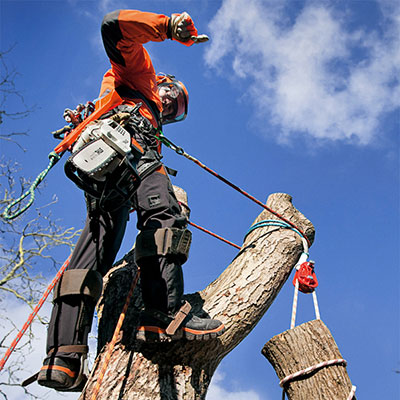
Accidents In The Arb Industry
Working outdoors, especially when dealing with dangerous equipment and a hazardous environment, requires careful attention to detail. This is especially true for forestry and arboriculture—both high-risk industries that involve aerial work and the use of machines like chainsaws and chippers.
Statistics from the Health and Safety Executive (HSE) shows that between the years 2000 to 2013, 60 people died as a result of tree work activities. Many more were injured or ended up with severe health conditions. In total, 4,000 lives have been affected by tree work injuries, effectively outnumbering the injury rate of those in the construction industry.
With this in mind, there is a pressing need for the industry and legislators to ensure that all regulation is fit for purpose and that the persons to whom these regulations and risk assessments apply, understand and follow them in full.
Accident Prevention Tips
A 2017 study by The Arboricultural Association (AA) found that 60% of practising arborists identified poor work positioning as the root cause of accidents in the workplace. One-handed chainsaw use came in second (24%), while less than 5% considered chainsaw kickback as a problem.
The same study found that the top three most likely contributors to accidents are time pressure, fatigue/loss of concentration, and industry/workplace culture (bravado).
Of course, there are a number of steps you can take to make sure your day-to-day activities and those of your colleagues or employees remain safe:
1. Tree climbing
Tree surgeons and arborists are always potentially at risk of falling from a tree, being hit by falling objects (e.g. tree, branches), or misuse of equipment. It’s just the nature of what they do.
An injury caused by misuse of equipment (configuration, operation, failure, or set-up) is one of the most causes of these incidents.
To prevent this from happening, it’s important to follow some basic steps:
- According to the Work at Height Regulations (WAHR) 2005, climbing work is only permitted if risk assessment is conducted, using safer work equipment is not needed, and that those conducting the work are sufficiently trained.
- Systems should be attached to two load-bearing anchor points, ensuring each point is strong enough to carry the climber, equipment, and other loads.
- Work positioning (e.g. climbing line) should be used if you have a backup system to prevent or arrest a fall. The user should also be connected to the backup system’s second line (if there is one).
- Rope access and positioning should be used if you have separate working lines (with a safe ascent/descent system and self-locking design) and safety lines (with mobile fail protection system). Users should then be connected to both lines, supported by a harness.
2. Aerial work
Aerial work presents a serious risk of injury by falling, or to ground staff through falling objects. 2017 data from the HSE found that falls from height is the topmost reason for fatal injuries to all outdoor workers across all industries.
All aerial work should be compliant to the WAHR and the Lifting Operations and Lifting Equipment Regulations 1998. Key points include:
- Chainsaws can only be used off the ground if the operator has received training and possesses the required qualifications.
- Aerial work needs a minimum of two people, with the ground team capable of prompt rescue. The outcome of the 2017 study by The Arboricultural Association (AA) states that “there are many circumstances where a properly planned and efficiently executed rescue and first aid provision will make the difference between life and death.”
- All operators are required to wear personal protective equipment.
- Ground staff needs to watch the climbers closely, provide tools when needed, make sure all ropes are safe and free of knots, and control working ropes so that they do not pose a risk to the climber.
- Ground staff should also make sure the work area remains safe from the public and any incoming traffic.
- Staying vigilant for any changes during the operation. If the risks fall outside the initial plan, don’t hesitate to stop and re-assess.
We have provided a lengthy guide on safely working outdoors, including working from a height and aerial tree work.
3. Chainsaws
According to the AA study, to improve the safety of top-handled chainsaws, technological advancements are needed. This includes consideration regarding a better bar/chain combination, as well as a safety sensor/control to prevent a one-handed operation.
However, no matter what additional safety controls may be developed, chainsaws will remain inherently dangerous and the biggest risk is the human element. Chainsaw incidents, whether causing fatalities or severe injuries, often involve operators taking shortcuts to save time. Whether you are using chainsaws for corrective or maintenance pruning or removing dead/diseased branches, you should conduct the following safety measures:
- Operators should always have received adequate training before conducting any work
- Under the Provision and Use of Work Equipment Regulations 1998, employers need to make sure that their operators are fit, both physically and mentally, to carry on with work.
- Conduct risk assessment prior to working, which includes identifying hazards and assessing human risks.
- No matter what the weather, always wear personal protective equipment, including chainsaw trousers, chainsaw boots, and a chainsaw helmet.
Don’t Cut Corners With Your Safety
Given the heightened risks of handling machinery, while conducting aerial work, you need to closely supervise your employees’ behaviours before and during operations.
This involves effective work planning—outlining a correct and safe work position that allows a user to cut with both hands on the saw. You should also keep communication lines open with your on-site team and regularly check on them. With lives on the line, you cannot cut corners with safety, no matter what the reason.
If you need help picking the right equipment for your team, feel free to give us a call on 01780 482231 or visit our shop at Stamford in Lincolnshire.
